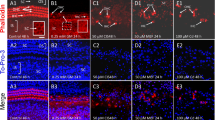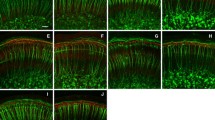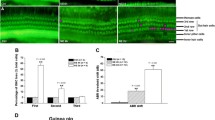Summary
The ototoxic action of nitromin on guinea pigs and mice was studied, Shaker-l-mice and Hedlund white mink cochlea were also studied with the comparison of nitromin intoxicated cochlea.
Nitromin was found to be more toxic than kanamycin, streptomycin and gentamicin with regard to their dosages. Toxic reactions were mainly observed in the cochlear sensory epithelia. Degeneration appeared first in the outer hair cells in the basal turn of the cochlea starting with the formation of whorls and proliferation of smooth endoplasmic reticula and ending with the complete degeneration of the sensory cells, but the stria vascularis showed little change. Even after the disappearance of the hair cells, some efferent nerve endings were still present in the organ of Corti.
Shaker mice have a fairly normal stria vascularis with normal filling of scaly media but show severe degeneration of organ of Corti. This cochlea shows pathological changes somewhat similar to those of ototoxic antibiotics intoxicated cochlea. On the other hand, Hedlund white mink showed the degeneration of the organ of Corti caused by severe degeneration of the stria vascularis and collapse of scaly media.
We have demonstrated similar final cochlear degeneration following different pathological pathways in three species of animals.
Zusammenfassung
Die ototoxische Wirkung von Nitromin wurde an Mäusen und Meerschweinchen studiert and die toxischen Veränderungen den morphologischen Bildern der Cochlea von Shaker-Mäusen und Hedlund-Nerzen gegenüber gestellt.
Es wurde festgestellt, daß die toxische Wirkung von Nitromin größer ist als die von Streptomycin and Kanamycin — bezogen auf die verabfolgte Dosis.
Toxische Veränderungen fanden sick hauptsächlich im Sinnesepithel der Cochlea. Zuerst kam es zum Untergang von äußeren Haarzellen in der basalen Schneckenwindung beginnend mit der Bildung von „Wirbeln” and der Proliferation des glatten endoplasmatischen Reticulums und endend mit der kompletten Degeneration der Sinneszellen, jedoch nur mit geringen Veränderungen in der Stria vascularis. Gleich nach dem Verschwinden der Haarzellen waxen immer noch einige efferente Nervenendungen im Corti-Organ vorhanden.
Die Shaker-Maus hat eine völlig normale Stria vascularis mit normaler Ausfüllung der Scaly media, abet One schwere Degeneration des Corti-Organs. Die Cochlea zeigt pathologische Veränderungen etwas ähnlich der durch ototoxische Antibiotica geschädigten Cochlea.
Auf der anderen Seite fmdet man bei Hedlund-Nerzen eine Degeneration des Cortischen Organs, hervorgerufen durch schwere Degeneration der Stria vascularis und durch Kollaps der Scala media.
Wir haben also ähnliche Formen von Cochlea-Degeneration bei drei Sorten von Versuchstieren gezeigt, die auf unterschiedlichen pathologischen Wegen zustande kommen.
Similar content being viewed by others
References
Anderson, H., Henricson, B., Lundquist, P. G., Wedenberg, E., Wersäll, J.: Genetic hearing impairment in the Dalmatian dog. Acta oto-laryng. (Stockh.) Suppl. 232, 1968.
Beagley, H. A.: Acoustic trauma in the guinea pig. II. Electron microscopy including the morphology of cell junctions in the organ of Corti. Acta otolaryng. (Stockh.) 60, 479–495 (1966).
Cummings, C. W.: Experimental observations on the ototoxicity of nitrogen mustard. Laryngoscope (St. Louis) 78, 530–538 (1968).
Deol, M. S.: Anatomy and development of the mutant Piroutte, Shaker-1 and Walzer mouse. Proc. roy. Soc. 145, 206–216 (1956).
Duvall, III., A. J., Rhodes, V. T.: Ultrastructure of the organ of Corti following intermixing of cochlear fluids. Ann. Otol. (St. Louis) 76, 688–708 (1967).
Duvall, A. J., Wersäll, J.: Site of action of streptomycin upon inner ear sensory cell. Acta oto-laryng. (Stockh.) 57, 581–598 (1964).
Engström, H., Ades, H. W.: Effects of high intensity noise on inner ear sensory epithelia. Acta oto-laryng. (Stockh.) Suppl. 219 (1960).
Gottesberge, M. A., Rauch, S., Koburg, E.: Untersehiede im Metabolismus der einzelnen Schneckenwindungen. Acta oto-laryng. (Stockh.) 59, 116–123 (1965).
Hiding, D. A., Sugiura, A., Nakai, Y.: Deaf white mink. Electron microscopic study of the inner ear. Ann. Otol. (St. Louis) 76, 647–663 (1967).
Kikuchi, K., Hilding, D. A.: The defective organ of Corti in Shaker-l-mice. Acta oto-laryng. (Stockh.) 60, 287–303 (1965).
− −: The spiral vessel and stria vascularis in Shaker-1-mice. Acta oto-laryng. (Stockh.) 63, 395–410 (1967).
Kimura, R. S.: Experimental blockage of the endolymphatic duct and sac and its effect on the inner ear of the guinea pig. Ann. Otol. (St. Louis) 76, 664–686 (1967).
Lundquist, P. G., Wersäll, J.: Kanamycin-induced changes in cochlear hair cells of the guinea pig. Z. Zellforsch. 72, 543–561 (1966).
-- The ototoxic effect of gentamicin. An electron microscopical study. Gentamicin First International Symposium, Paris. 1967.
Morimitsu, T.: Recent advances in pathogenesis of inner ear deafness. Electrophysiological investigation. Jap. J. Otol. Tokyo 72, 603–606 (1969).
Nakai, Y.: Histochemical study of the stria vascularis in the inner ear by electron microscopy. Ann. Otol. (St. Louis) 74, 326–337 (1965).
−: Recent advances in pathogenesis of inner ear deafness. Electron microscopy of the cochlea. Jap. J. Otol. Tokyo 72, 629–632 (1969).
−, Hilding, D. A.: Electron microscopic studies of adenosine triphosphatase activity in the stria vascularis and spiral ligament. Acta oto-laryng. (Stockh.) 62, 411–428 (1966).
−: Adenosine triphosphatase distribution in the organ of Corti. Acta otolaryng. (Stockh.) 64, 477–491 (1967).
−: Cochlear development. Some electron microscopic observations of maturation of hair cells, spiral ganglion and Reissner's membrane. Acta otolaryng. (Stockh.) 66, 369–385 (1968).
Schuknecht, H. F.: The pathology of several disorders of the inner ear which cause vertigo. Sth. med. J. (Bgham, Ala.) 57, 1161 (1964).
Wilson, T. G., Kane, F.: Congenital deafness in white cats. Acta oto-laryng. (Stockh.) 50, 269–277 (1959).
Wachstein, M., Meisel, B.: Histochemistry of hepatic phosphatases of a physiologic pH. Amer. J. clin. Path. 27, 13–23 (1957).
Author information
Authors and Affiliations
Rights and permissions
About this article
Cite this article
Nakai, Y., Nakai, S. Ototoxic effect of nitromin and some congenital deaf animal cochlea. An electron microscopical study. Arch. Klin. Exp. Ohr.-, Nas.- U. Kehlk. Heilk. 198, 325–338 (1971). https://doi.org/10.1007/BF00316933
Received:
Issue Date:
DOI: https://doi.org/10.1007/BF00316933




